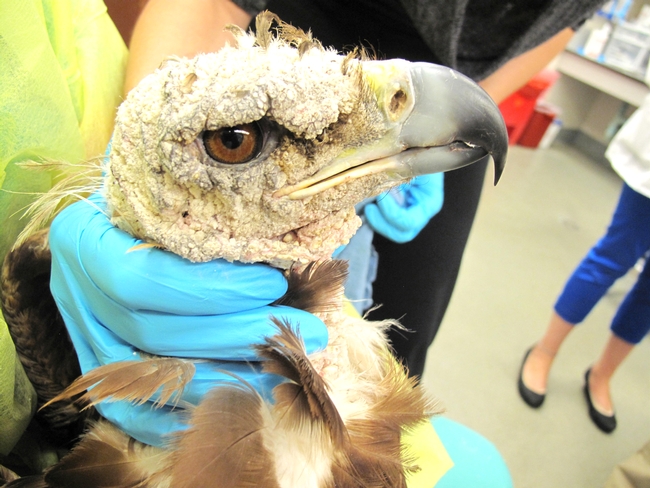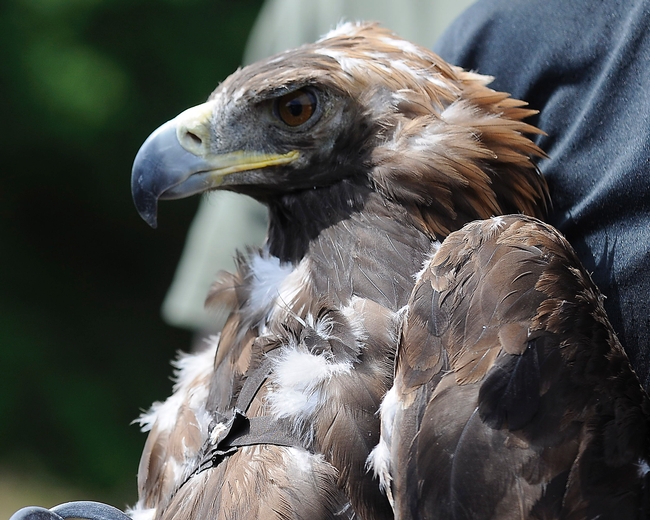Posts Tagged: California Raptor Center
UC Davis Biodiversity Museum Day: See 'Bird's Eye View' at the Raptor Center
Last year during the 12th annual UC Davis Biodiversity Museum Day, visitors to the California Raptor Center, 1340 Equine Lane, off Old Davis...

This is the newly installed mural, "Bird's Eye View," which visitors to the California Raptor Center, UC Davis campus, can see during the UC Davis Biodiversity Museum Day on Saturday, Feb. 10. (Photo by Diane Ullman, UC Davis distinguished professor of entomology and artist)
Exotic mange found in California golden eagles
Golden eagles in the western United States may be at risk of infestation by an exotic and possibly new species of mite that causes a fatal skin disease, according to an Emerging Infectious Diseases case report published in October 2014.
Two adult golden eagles that were recovered in California between July and August 2013 were infested by a mite with morphologic features similar to those of Micnemidocoptes derooi, a species of mite seen only once, in an African palm swift in West Africa more than 40 years ago.
Both eagles had substantial feather loss and scabbing on the head, neck, and legs and near the cloaca. One of the raptors was found grounded and so ill the animal was euthanized. The other was live-trapped, rehabilitated, and eventually returned to the wild. (She underwent 8 months of recovery and rehabilitation at the California Raptor Center, a program of the UC Davis School of Veterinary Medicine. Read her story here.)
A third golden eagle, found in December the previous year in the same region as the others, was likely also infected by the Micnemidocoptes–like mite, according to the report. The bird had been struck by a car and died of its injuries.
In their report, the authors note that while wild raptors can sometimes become infested with mites, such debilitating mange in otherwise healthy animals is highly atypical.
“The severity and diffuse distribution of skin lesions of these eagles suggest a possible serious, unique outbreak,” they wrote.
Additional golden eagles with suspicious feather loss have been spotted in California and Nevada since August 2013.
Dr. Michelle Hawkins is director of the California Raptor Center at the University of California-Davis School of Veterinary Medicine and one of the report's co-authors. Her team spent several months treating the golden eagle that was eventually healthy enough to be released. Dr. Hawkins said mites in the Knemidocoptinae subfamily typically infest a bird's non-feathered areas, such as its face, beak or legs. The mites on the golden eagles are unusual because they only affected the feathered areas.
Feather loss impacts an eagle's ability to maintain normal body temperature and may limit the animal's ability to obtain food, making it weak and susceptible to trauma. Severe mite infestation is unusual in birds, especially adult birds. No such infestation among golden eagles has been previously reported.
“It's all very strange,” Dr. Hawkins admitted. “It's not something that's been identified by any researchers that we're aware of at that point. This may be closely related to M derooi but has not been previously described.”
As for how this potentially novel species of mite arrived in the United States and is spreading, they are also mysteries. The entire life cycle of M derooi is reported to be spent on its host, so theoretically, transmission would require direct contact between birds. Dr. Hawkins supposes the mites could be passed along through an infested bird's nest, although additional research is needed in this and other areas involving this mite.
In the meantime, the California Department of Fish and Wildlife is asking residents to report golden eagles or other large birds with severe feather loss. Dr. Hawkins has written a paper on the clinical treatment of eagles with mange, which is expected to be published in the near future.
The article, “Knemidocoptic mange in wild golden eagles, California, USA,” is also available online.
This article originally appeared in JAVMA News by Scott Nolen.



